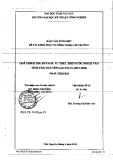
Hindawi Publishing Corporation
EURASIP Journal on Advances in Signal Processing
Volume 2007, Article ID 19260, 8pages
doi:10.1155/2007/19260
Research Article
Classification of Crystallographic Data Using
Canonical Correlation Analysis
M. Ladisa,1A. Lamura,2and T. Laudadio2
1Istituto di Cristallografia (IC), CNR, Via Amendola 122/O, 70126 Bari, Italy
2Istituto Applicazioni Calcolo (IAC), CNR, Via Amendola 122/D, 70126 Bari, Italy
Received 28 September 2006; Revised 10 January 2007; Accepted 4 March 2007
Recommended by Sabine Van Huffel
A reliable and automatic method is applied to crystallographic data for tissue typing. The technique is based on canonical cor-
relation analysis, a statistical method which makes use of the spectral-spatial information characterizing X-ray diffraction data
measured from bone samples with implanted tissues. The performance has been compared with a standard crystallographic tech-
nique in terms of accuracy and automation. The proposed approach is able to provide reliable tissue classification with a direct
tissue visualization without requiring any user interaction.
Copyright © 2007 M. Ladisa et al. This is an open access article distributed under the Creative Commons Attribution License,
which permits unrestricted use, distribution, and reproduction in any medium, provided the original work is properly cited.
1. INTRODUCTION
One of the main goals of tissue engineering is the recon-
struction of highly damaged bony segments. To this aim, it
is possible to exploit the patient’s own cells, which are iso-
lated, expanded in vitro, loaded onto a bioceramic scaffold,
and, finally, reimplanted into the lesion site. Generally, bone
marrow stromal cells (BMSC) are adopted, as described in
[1]. In this respect it would be important to characterize the
structure of the engineered bone and to evaluate whether the
BMSC extracellular matrix deposition on a bioceramic scaf-
fold repeats the morphogenesis of the natural bone develop-
ment. In addition, it is also interesting to look into the inter-
action between the newly deposited bone and the scaffold in
order to recuperate damaged tissues. This is due to the fact
that the spatial organization of the new bone and the bone-
biomaterial integration is regulated by the chemistry and the
geometry of the scaffold used to place BMSC in the lesion site
[1–3].
In this context the standard crystallographic approach to
detect the different tissues is based on a quantitative analy-
sis performed by the Rietveld technique [4,5]. This method
allows to determine the relative amounts of different tissue
components but it is rather sophisticated and computation-
ally demanding. The aim of this paper is to propose a new
technique based on a statistical method called canonical cor-
relation analysis (CCA) [6]. This method is the multivari-
ate variant of the ordinary correlation analysis (OCA) and
has already been successfully applied to several applications
in biomedical signal processing [7,8]. Here, CCA is applied
to X-ray diffraction data in order to construct a nosologic
image [9] of the bone sample in which all the detected tis-
sues are visualized. The goal is achieved by combining the
spectral-spatial information provided by the X-ray diffrac-
tion patterns and a signal subspace that models the spectrum
of a characteristic tissue type. Such images can be easily in-
terpreted by crystallographers. The paper is organized as fol-
lows. In Section 2, we present the mathematical aspects of
the CCA method. Then the application of CCA to crystal-
lographic data is reported in Section 3.InSection 4, the nu-
merical results are described and discussed and, finally, we
draw our conclusions.
2. CCA
CCA is a statistical technique developed by Hotelling in 1936
in order to assess the relationship between two sets of vari-
ables [6]. It is a multichannel generalization of OCA, which
quantifies the relationship between two random variables x
and yby means of the so-called correlation coefficient
ρ=Cov[x,y]
V[x]V[y],(1)
where Cov and Vstand for covariance and variance, re-
spectively. The correlation coefficient is a scalar with value






























